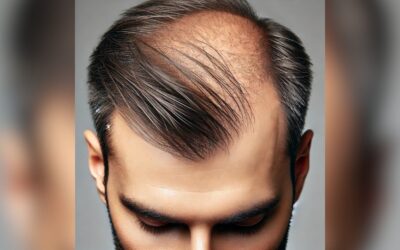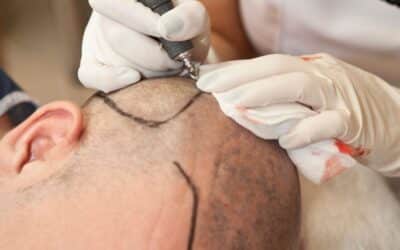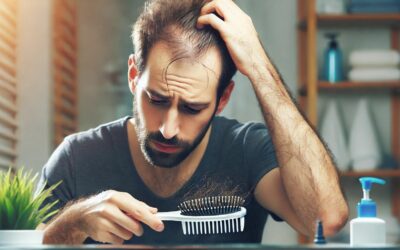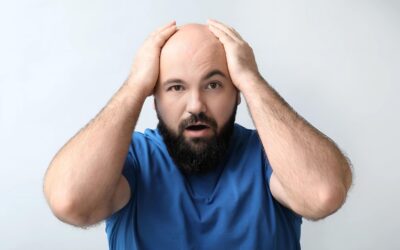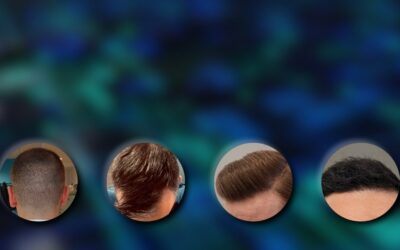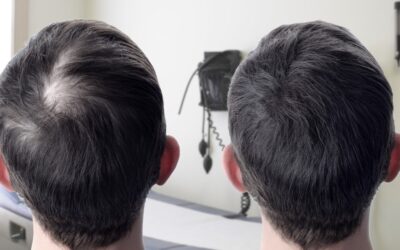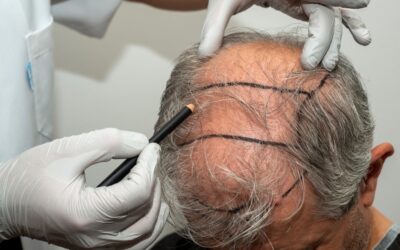A hair replacement system is basically another term for a hairpiece or toupee. However, they are usually more expensive, as more time goes into prepping and applying them. There are many different products that constitute hair replacement systems including toupees, wigs, strand-by-strand insertion systems, hairpieces, etc. All of these products are prosthetic hairpieces. However, the materials used to build them, and the quality of the product can vary wildly.
In the end, it’s all about how much you’re willing to spend. And, of course, how much time you want to dedicate to your new look. In this article, we will discuss some of the different types of hair replacement systems that exist. Additionally, we’ll talk about their various pros and cons. Finally, we’ll try to decide which hair replacement system is right for you, or if a better option exists.
Hair Replacemennt System Basics
The cost and appearance of a hairpiece vary depending on the types of materials, as well as the level of craftsmanship used to construct it. Ventilation is a must! The base of the hair replacement system must allow airflow. After all, just because you are losing hair doesn’t necessarily mean you’ve gone completely bald. In fact, that’s not usually the case for the average hair loss sufferer. As most thinning and balding scalps still have some fuzz or whisps of hair remaining, caution must be taken. Otherwise undesirable conditions such as scalp irritation, fungus infections, or further damage to your natural hair could result.
Without ventilation these hair systems would be horribly hot and uncomfortable to wear, making for an unpleasant user experience. The bases of hair systems are typically made from either lace, polyurethane (PU), or monofilament (mono) bases. The stylist uses tape and glue to secure them to the scalp. Depending on the product, some are designed to be worn for up to several weeks at a time. You can sleep in them, shower in them, swim in them, and exercise as well. Pretty much anything you would be able to do with just your own natural head of hair.
Comfort is Key
Hair systems should become a comfortable part of your day-to-day lifestyle. And that makes sense. After all, you shouldn’t have to obsess about it while you’re wearing it. However, a hair system will add additional steps to your personal grooming routine. It’s customary that hair replacement system users may need to reattach the part of the hairpiece every few days, or every week or so they will need to reattach the whole unit. You must remove and clean the hair system. You’ll also have to wash your scalp regularly. Many hair system users choose to shave the hair underneath the hair system. This helps the hair replacement system to stay put. These are all regular practices for hair system users.
Types of Hair Replacememnt Systems
Mesh Fabrics
Mesh fabric bases for hair systems are usually made of either polyester or nylon. They are generally used to help create the look of a fine hairline. These can provide a very natural and life-like appearance, that is virtually undetectable. They are also very lightweight, and because of the airiness of the mesh, keep the head cool and comfortable.
Unfortunately, because they are so delicate, they are rather impractical for daily, long-term use. They also tend to be more expensive even though they are less durable. Over time the materials react to body acids which can lead to degradation and damage of the product. This means that these hair systems must be replaced more frequently, increasing your expense even further.
Polymer Bases
Polymer bases are made of either silicone or polyurethane. These are used to build a material that mimics the appearance of natural skin and scalp. More durable hair systems tend to use this material, especially in the areas where the hair piece will be attached to the scalp because it helps to protect the unit for long-time use. These tend to be less expensive than meshes and considerably more durable. They are easy to attach as well. Unfortunately, when working with polymer bases for hair systems, many users report that they are extremely hot and uncomfortable.
Depending on the quality or level of craftsmanship, some of these products can wind up giving the wearer a look that does not appear very natural, even artificial. That’s the last thing you want. Hair systems that use a combination of a polymer base at the center of the hair unit with lace mesh at the hairlines tend to give an appearance that is less detectable.
Human Hair Replacememnt Systems
Different types of materials are used to build the hair in a hairpiece too. The best pieces available are custom-made. High-quality human hair that has been matched to blend in with the color and texture of the client’s hair is used. Any natural curl, wave or straightness, as well as the density of the hair is also taken into account. Basically, you can create any hair style you want. And that’s a pretty awesome feature. No way around that. You’ll style and cut it just like a regular haircut. The most expensive and mid-priced hair systems are made from European hair that is often selected for their variety of color, texture, density, level of curl, wave, or straightness.
Human Hair Is Fragile
Less expensive hair systems tend to be made from dark, straight Asian hair. Oftentimes, it’s dyed or bleached to achieve the desired hue. Although Asian hair is very strong, the coloring processes can make it look dry and brittle. Consequently, this makes it susceptible to breakage. After a while, these hair pieces tend to start looking a little fuzzy and need to be replaced more frequently.
No matter what, at the end of the day, human hair is fragile. Even with the most expert craftsmanship, hair replacement systems will require regular maintenance and will need to be regularly replaced. If you are going to commit to a hair replacement system, it will be important that you budget for replacement hair pieces, any tapes or adhesives, as well as any personal care products you may need to feel comfortable while wearing these hair pieces.
Because human hair is fragile, it is also important that you consider the fact that hair pieces often accelerate hair loss in the area directly under the hair unit. The way you attach your hair pieces will also have an impact on the hair that is directly under or adjacent to the attachment sites. Especially when it comes to hair pieces that are attached by bonding, a very strong glue-like adhesive. Clip-in hair systems tend to cause less hair loss than hair that is installed through a weaving process.
What You Can Expect From A Hair Replacement System
Semi-permanent attached hair pieces are professionally installed by a hair technician or stylist. They are semi-permanently attached and are not designed to be removed by the user themselves. Every 6 weeks these hair pieces must be removed and reinstalled. This is both costly and time-consuming. Most often these hair systems are affixed to the scalp using various liquid adhesives. This technique falls under many names such as poly-fuse, natural bond, polybond, or simply “bonding” to the scalp. All of these terms are describing the process of gluing a hairpiece to one’s head. When it comes to the health of your hair and scalp, bonding is not necessarily the healthiest practice.
The natural accumulation of flaked off skin cells, as well as oils, shed hair, and other organic materials build up in between the hair piece and the surface of the scalp. Other semi-permanent attached hair pieces are installed by wearing the natural hair into the bottom of the hair piece in order to secure it to the head. It is vital that these hairpieces be removed or loosened at least every five days in order to ensure that the scalp is properly cleaned and cared for. Failure to do this could result in nasty infections on the surface of the scalp, and further loss of hair, as well as destruction to the hair piece itself.
Attaching Hair Replacement Systems
Clip attachments use metal clips that are connected to the underside of the hairpiece unit. These fasten to your natural hair that is either under or adjacent to the hair piece. These are secure when worn, but easy to remove. Hair extensions are a type of clip attachment that can be individually placed throughout the hair. They give the hair a fuller appearance, as well as give the appearance of longer hair. They are not effective for disguising hair loss related to pattern baldness in most instances.
Hair extensions can provide the user with the instant gratification of a dramatic new look, and have some versatility in terms of how the hair can be styled. They can give you an opportunity to be creative with your look, which can be a lot of fun. Clip attachment hair extensions are easy to remove. You can wear them as much or as little as you like.
The Downsides to Hairpieces
Some hair pieces attach using double-sided tape. The downside is that it can leave a sticky residue on the scalp as well as the underside of the hair piece. You will need to wash this residue off of your scalp. Additionally, hair systems that adhered with tape are more prone to becoming unglued, especially if you perspire heavily. Swimming and exercise, or even just the friction of rolling around in bed can loosen the adhesive tape as well.
The downside to working with clip-in and weaved-in hair extensions and hair systems is the risk of traction alopecia. Traction alopecia is a condition that can result in hair loss, due to the amount of weight that the clip in, or weaved in extensions add to the hair. These hair systems pull on the hair, increasing the tension at the root, irritating the hair follicle, and causing the hair to fall out. Increased hair breakage and irritation to the scalp, including small pimple-like bumps, can develop on the scalp as well.
If you are currently experiencing significant hair loss, hair replacement systems can offer some advantages. Surgical procedures such as hair transplantation usually have a recovery time of at least two weeks, and the surgery itself is time-consuming. Not to mention that you may experience some discomfort in the early days following surgery. Hair replacement systems may seem more convenient. Compared to the cost of undergoing hair transplant surgery, wearing a hair replacement system appears like the more affordable option at first glance.
Negative Outcomes & Dissapointment
When we explore some of the disadvantages of hair replacement systems, there are certainly some things that should give you pause. According to the American Hair Loss Association, more than 70 percent of consumers who use non-surgical hair loss products report negative outcomes. Inexpensive hair systems tend to look artificial, unconvincing, and cheap, they are not worth wasting your hard-earned money on.
Higher-quality hair systems that look natural and undetectable are expensive. However, they must be purchased again and again. Forever. Many of these hair replacement systems are designed to only last for a few weeks. Some, a few months. In the long term, when you compare the cost of a hair transplant surgery with having to repeatedly purchase hair replacement systems on a regular basis, the difference or any potential savings is minimal at best.
There’s no way to definitively predict how long your hair replacement system will last. At some point, you’ll need to replace it. They may look nice in the short term, but there’s a lot of work involved in the long term. It’s a similar choice when using drugs like Finasteride and Minoxidil. Do you go for the short-term solution or the long-term solution? Do you want to spend money now or later? Many factors including the base materials, and how well you take care of your hair replacement system will contribute to its longevity. Following some simple guidelines can help you to maximize the number of times you can wear your hair replacement system.
Tips
Avoiding the use of hot water, blow-dryers, and other heat styling tools on your hairpiece. Do not use any shampoos that contain harsh ingredients, use gentle formulations that are free of parabens, as well as any hair products that contain alcohol, which can be very drying to the hair. Try your best to use minimal styling products, which can build up in the hair. Sleep with a satin pillowcase to minimize friction. You also extend the life of your hair replacement system by remembering to avoid the following: treating the hair roughly, shampooing too often, swimming in overly chlorinated pools, not washing enough, or allowing products to build up. All of those things will degrade the quality of your hair system faster.
Hair Transplant Surgery is Also an Option
The prospect of undergoing hair transplantation surgery may feel a bit intimidating to consider at first. The reality is that if you have been suffering from thinning hair or hair loss, hair transplantation is one of the most highly effective ways to reverse the appearance of lost hair. After all, this option is both a natural and permanent solution. The surgery does not replace lost hair, but the transplants can help to fill in areas of the scalp that have experienced significant hair loss.
There are two primary methods for performing hair transplants; Follicular Unit Transplantation (FUT) and Follicular Unit Extraction (FUE). With both of these procedures, the method of transplanting the harvest follicular grafts is the same. The processes differ when it comes to the method of harvesting the grafts themself. With FUT the follicular grafts are harvested by removing a small strip of the scalp from the back or sides of the head. This type of surgery requires sutures at the donor site.
With FUE, the follicular grafts are harvested individually in a pattern that is dispersed throughout the back of the head. A good surgeon will leave virtually undetectable scars when healed. FUE is a less invasive procedure. It’s also more expensive. That’s because it’s often more time-consuming. Both are virtually equal in terms of effectiveness when it comes to the transplanted grafts surviving and thriving after surgery.
The Process
Both are outpatient procedures. You will be awake throughout the surgery but mildly sedated. The initial healing process after surgery takes about two weeks. It can take up to a year to see full and noticeable results from your surgery. Furthermore, at about 4 months post-op, shock loss can occur. This is when the old hairs from the transplanted grafts are shed, to make way for the new hair that is below the surface of the scalp to grow in. This is a completely natural part of the process. You’ll see permanent wew growth after about 9 months.
Hair transplantation is a process that does require patience in order to achieve your desired look, but the end results have many more advantages than hair replacement systems. You don’t have to worry about tapes, or glues, or re-purchasing hairpieces. You don’t have to worry about your hairpiece becoming unglued or dislodged in public, which could be potentially embarrassing. Instead of risking the health of the remaining hair that is on your head, you can see new, natural hair flourishing again. You can swim, and shower, and exercise without worrying that your hairpiece is becoming damaged. You don’t have to worry about your hairpiece appearing conspicuous and artificial.
Low-Level Laser Therapy For Hair Replacement
Incorporating low-level laser therapy (LLLT) after you have healed from surgery is a great way to further ensure that your transplanted hair will grow long, strong, and lustrous for many years to come. It can stimulate the scalp and help you stop hair loss in its tracks. Additionally, lasercaps like the Capillus RX can help you regrow hai rover time. They are also great additions to hair restoration routines and work well with FUT and FUE hair transplants.
LLLT stimulates the cells responsible for the regeneration of the hair follicle as well. The light from the lasers also increases blood flow to the scalp, which improves the optimization of nutrients and oxygen by the hair follicles. This causes the hair to grow to an increased length and diameter. The hair itself will often be less prone to breakage, and shinier as well.
Learn More About Hair Replacement
Want to learn more? Book a complimentary consultation today. We can meet with you either in person or virtually and are happy to answer all your questions. We offer the best prices on hair transplants in the LA area, and we can help you come up with a treatment plan that will work with your budget. Don’t waste any more money on temporary solutions like hair replacement systems. They may disguise your hair loss in the short term, but only make the problem worse in the long term. Let us show you a better way. Your natural hair restoration is worth the investment.
SUFFERING FROM HAIR LOSS?
Best Hair Transplant is the best place to schedule your hair transplant in Los Angeles. We’ve helped both men and women regrow their lost hair. But don’t take our word for it. We suggest learning as much as possible about hair restoration. Do so prior to making a decision on how to address your hair loss. Not every procedure is right for everyone.
At Best Hair Transplant, we’re proud of our results and happy to provide hair restoration services. Additionally, we’re proud to make hair transplants affordable and help you save money on a variety of hair transplants.
To ensure your ease of mind, you can view our customer recommendations HERE. Furthermore, you can also see our Google reviews and Yelp reviews. We can’t wait to help you start restoring your lost hair.
YOUR HAIR RESTORATION SOLUTION
Best Hair Transplant
1970 S. Prospect Ave., Suite 2
Redondo Beach, CA 90277
(213) 403-0455
References:
- https://www.hairclub.com/blog/how-modern-hair-systems-work/
- https://www.forhims.com/blog/hair-replacement-systems
- https://www.webmd.com/skin-problems-and-treatments/hair-loss/hairpiece-basics
- https://www.lordhair.com/blog/permanent-wig-attachment/



